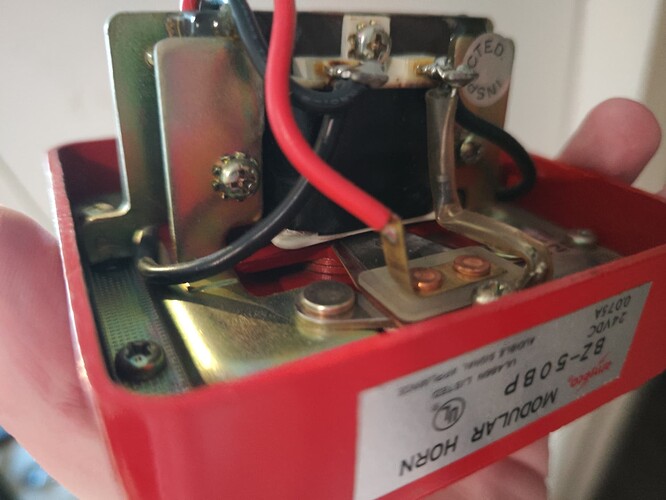I’m curious on what makes the sound on a Mechanical Horn. Anyone know how they work?
There used to be some animated diagrams on NewAgeServerAlarm’s old website that illustrated the various ways electromechanical horns work very well, but them & his website are both no longer available. In general though electromechanical horns move a plate called a “diaphragm” back & forth very rapidly when power is applied to them, which creates sound through disturbing the air (which is where all sound comes from/how all sound occurs), how they actually do so varies by horn however: most use an electromagnet to move the diaphragm, while some use a motor (which are called “motor horns”. The only manufacturer I’ve known to make motor horns is Amseco: apparently they weren’t very popular). Likewise the mechanism that controls the diaphragm-moving component can vary as well: a lot of electromechanical horns use a pair of metal contacts that are opened & closed as the diaphragm moves/the horn operates, while others like some made by Faraday use a circuit board to control the diaphragm’s movement instead.
The main way they work is when the diaphragm of the Mechanical horn vibrates.
I get the idea, but i’m curious on what it looks like.
This may not be the most accurate explanation, but I’ll try my best:
Imagine there’s a small tab attached to the diaphragm, then that tab goes to a a coil (electromagnet), when you apply power, the coil will pull the tab (and therefore the diaphragm with it). Now, picture that tab getting pulled up and pushed down 60 times per second (at least on AC powered horns, not counting the period between two oscillations where the voltage goes to zero).
Boom. That’s more or less how a AC horn works. Aquarium air bubbler pumps work on the same principle.
Now for DC powered horns, things are a little different because there’s no such thing as frequency there.
Instead (most) DC powered horns work on the same principle as AC horns but with a contactor added that cuts power to the coil when the diaphragm gets pulled up, in turn causing the diaphragm to drop thus closing back up the contactor, then the coil energizes back, and the cycle repeats.
(this is true to most DC powered horns, there’s some DC horns that uses a circuit to generate a AC waveform out of a DC input, the FHF HGK horns rely on this.)
Now all of this is for “vibrating” horns (sometimes referred to as “Vibratone horns”, some horns, however, instead of using a coil, use a motor attached to a cam to push the diaphragm up and down, one notable example is the Amseco BZ-54VT motor horn.
Here’s a picture of (coincidentally) my Amseco BZ-50P, you can just faintly see the contact that cuts power when the diaphragm is pulled by the coil, if you look closely you can also see the plunger that connects the coil to the diaphragm.
Ahh, thank you!! That makes So MUCH more sense.
It’s not really like a bell gong being vibrated, The way a mechanical horn vibrates is when the Diaphragm receives filtered AC, the diaphragm gets the AC power it needs to function, Thus when this happens, the Horn diaphragm is activated and begins vibrating on the horn. Kind of like a Klaxon horn that once powered begins vibrating on any nearby metal object and in turn the metal helps amplify the sound of the horn.
I also though I created this topic lol
I created this last year.
